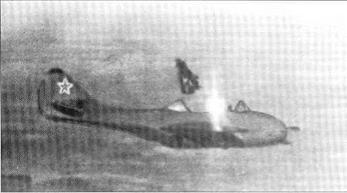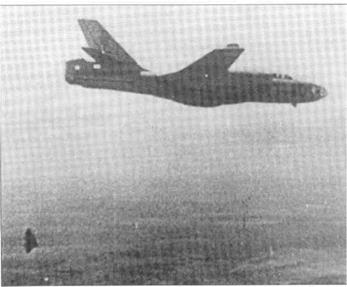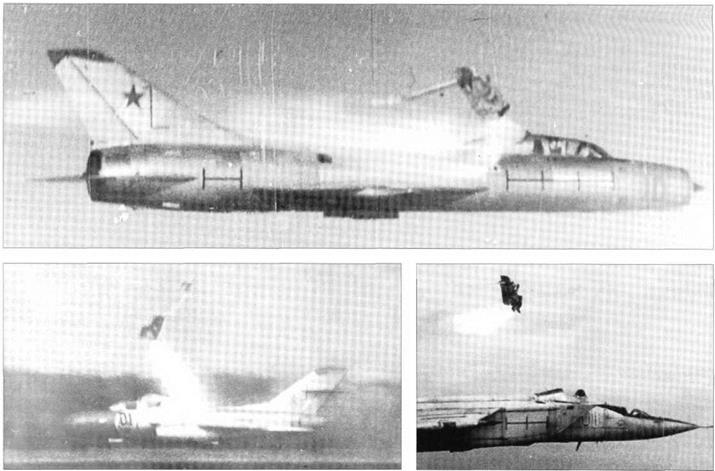Ejection-seat Test-beds
Purpose: To modify established jet aircraft in order to test ejection-seats.
Design Bureau: Initially the seats were designed by special teams formed in the jet – aircraft OKBs. However, in 1952 a special organization was created to specialize in life-support and safety-equipment systems, and in 1994 this was transformed into NPP Zvezda (Star) joint-stock company. From the 1960s this organization captured the market until it was providing ejection-seats for virtually all Soviet combat aircraft.
Soviet ejection-seats, called Katapul’tnoye Kreslo, were initially diverse, and drew heavily on designs by US, Swedish and, especially, the British Martin-Baker companies. After 1945 a few flight tests took place with German seats, developed in 1944 for such aircraft as the He 219 and Do 335. The detailed history has not been written, but some of the earliest
flight tests were carried out from about mid – 1947. Probably the first Soviet ejection-seat was designed in the MiG OKB from January
1947. On 11th March 1947 this OKB received an order to test this seat in the FT-2, the second prototype of the M1G-9UTI trainer. After ten test ejections in a ground rig the experimental seat, weighing 128.5kg (283 Ib), was initially installed in the considerably modified rear cockpit of FT-1 (the first two-seater which was still with the MiG OKB). Flight testing took place throughout the first half of
1948, but only up to 700km/h (435mph). The very similar FT-2 was then fitted with two ejection-seats, the front one at a rail angle of 22.5° and the rear at 18.5°. The modified aircraft was delivered to NIl-WS, the air force flight test institute, on 29th September 1948. After two tests with dummies live testing continued between 7th October and 13th November 1948. An automatic sequence firing
the canopies and seats was then perfected (though ofcourse the FT-2 was never left with both cockpits empty). From the results of these tests the OKB gradually developed the first production seat, called the SK. This was then developed through 14 production series.
Probably the next Soviet aircraft to be used for ejection-seat testing was the Ilyushin IL-28 tactical twin-jet bomber. First flown on 8th July 1948, using the imported Rolls-Royce Nene and later the Nene-derived RD-45 and VK-1 A, this excellent aircraftwas used for surprising tests using seats fired from the extreme tail. Unlike the very similar British Canberra, which was undefended, for this aircraft the Ilyushin OKB developed a powerful tail turret with two NR-2 3 guns, manned by the radio operator who had an escape chute. In several aircraft the turret was replaced by a special test installation for an ejection-seat. Both upward – and downward-firing seats
|
|||
|
|||
|
|
||
|

![]()
|
were tested, and cine films showed that in some cases firing the seat imparted to the aircraft a pronounced kick in the pitching plane, either nose-up or nose-down. Some of the IL-28 seat tests were at airspeeds exceeding 800km/h (497mph).
Even higher speeds were reached during seat testing with ST-10 aircraft, which were specially modifiedtwo-seat UTI MiG-15s. This was the principal type used from 1951 onwards in development of the SK and SK-1 seats which were used in thousands of early MiG jets, and later for the much better KM-1 family used in later MiG fighters, cine films and photographs have shown seats being fired from ST-lOs with callsigns 15, 23, 101U, 102U and 401U. These aircraft were painted with bold horizontal black lines in known positions to assist determination of the seat trajectory. What is surprising is that about half the photographs of tests appear to have involved firing the test seat from the front cockpit. Using dummies and human occupants many hundreds of combinations of canopy, seat, ejection gun, stabilizing drogue and parachute system were investigated. Early SK seats were notoriously unreliable, and when they did fire on command the pilot often suffered spinal damage. Gradually, and especially after the ST-10 testing began, the SK seats improved. A faceblind was provided to
protect the occupant’s face, additional firing triggers were incorporated in both armrests, improved ejection guns were developed imparting a precisely repeatable phased acceleration using different cartridges for summer and winter, and the original restrictive limits of airspeed and altitude were progressively increased. A photograph shows 101U, one of the aircraft with a completely open front cockpit. The final ST-10,401U, was fitted with a new type of front-cockpit canopy which was hinged at the rear to the top of the seat so that on ejection the canopy served as a windbreak to protect the occupant. This became a feature of early MiG-21 fighters.
Photographs have been found of at least two Yak-25L (Laboratoriya) seat-test aircraft. The production night fighter seated the pilot and radar operator in tandem under a large one-piece canopy which opened by sliding on rails 2.2m (7ft Sin) to the rear. Both the seat test-beds had a pressure bulkhead separating the front cockpit from the rear cockpit, from which the seat under test was fired. Aircraft callsign 18 retained the original type of canopy but with the portion over the rear cockpit opaque (on being jettisoned this usually passed perilously close to the tail). Aircraft callsign 01 had a completely modified arrangement, the pilot having a short upward – hinged canopy and the test cockpit having a
prominent light-alloy superstructurewhich in most tests was open at the top. This aircraft was later used to test the Yakovlev OKB’s KYa-1 rocket-boosted seat, the first to have ‘zero/zero’ capability (able to be fired with the aircraft at rest on the ground).
The only Sukhoi aircraft known to have been an ejection-seat test-bed was an Su-9U with callsign Red 10. Liberally covered on the starboard side with black lines for use as trajectory references, this Mach-2 aircraft always fired the test seat from the rear cockpit. This was open-topped and sealed from the pressurized front cockpit. The only photographs released on this aircraft must have been taken since the 1970s, as they show modern Zvezda zero/zero rocket assisted seats, at least one being of the K-36 family. One photograph shows a test at ground level.
While the Su-(U was used for tests at high subsonic Mach numbers, at least on M1G-25U has been used to confirm behaviour in ejections at supersonic speeds. Details of the seats and Mach numbers have yet to be disclosed, but Zvezda believe this aircraft has been used to check successful ejections at mach numbers significantly higher than anywhere else in the world.
|















